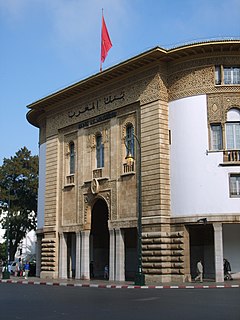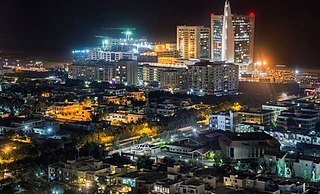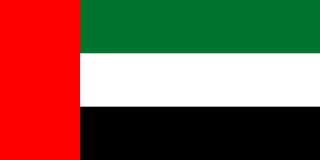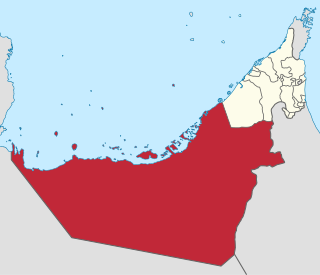Related Research Articles

The economy of Kazakhstan is the largest in Central Asia in both absolute and per capita terms, but the currency saw a sharp depreciation between 2013 and 2016. It possesses oil reserves as well as minerals and metals. It also has considerable agricultural potential with its vast steppe lands accommodating both livestock and grain production. The mountains in the south are important for apples and walnuts; both species grow wild there. Kazakhstan's industrial sector rests on the extraction and processing of these natural resources.

The economy of Morocco is considered a relatively liberal economy governed by the law of supply and demand. Since 1993, Morocco has followed a policy of privatization of certain economic sectors which used to be in the hands of the government. Morocco has become a major player in African economic affairs, and is the 5th largest African economy by GDP (PPP). The World Economic Forum placed Morocco as the 1st most competitive economy in North Africa, in its African Competitiveness Report 2014-2015.

The economy of Pakistan is the 24th largest in the world in terms of purchasing power parity (PPP), and 42nd largest in terms of nominal gross domestic product. Pakistan has a population of over 212.2 million, giving it a nominal GDP per capita of $1,357 in 2019, which ranks 154th in the world and giving it a PPP GDP per capita of 5,839 in 2019, which ranks 132th in the world for 2019. However, Pakistan's undocumented economy is estimated to be 36% of its overall economy, which is not taken into consideration when calculating per capita income. Pakistan is a developing country and is one of the Next Eleven countries identified by Jim O'Neill in a research paper as having a high potential of becoming, along with the BRICS countries, among the world's largest economies in the 21st century. The economy is semi-industrialized, with centres of growth along the Indus River. Primary export commodities include textiles, leather goods, sports goods, chemicals, carpets/rugs and medical instruments.

The economy of Switzerland is one of the world's most advanced free market economies. The service sector has come to play a significant economic role, particularly the Swiss banking industry and tourism. The economy of Switzerland ranks first in the world in the 2015 Global Innovation Index and the 2017 Global Competitiveness Report. According to United Nations data for 2016, Switzerland is the third richest landlocked country in the world after Liechtenstein and Luxembourg, and together with the latter and Norway the only three countries in the world with a GDP per capita above US$70,000 that are neither island nations nor ministates.

The economy of the United Arab Emirates is the second largest in the Middle East, with a gross domestic product (GDP) of USD 414 billion in 2018.

The United Arab Emirates, sometimes simply called the Emirates, is a country in Western Asia at the southeast end of the Arabian Peninsula on the Persian Gulf, bordering Oman to the east and Saudi Arabia to the south and west, as well as sharing maritime borders with Qatar to the west and Iran to the north. The sovereign constitutional monarchy is a federation of seven emirates consisting of Abu Dhabi, Ajman, Dubai, Fujairah, Ras Al Khaimah, Sharjah and Umm Al Quwain. Their boundaries are complex, with numerous enclaves within the various emirates. Each emirate is governed by a ruler; together, they jointly form the Federal Supreme Council. One of the rulers serves as the President of the United Arab Emirates. In 2013, the UAE's population was 9.2 million, of which 1.4 million are Emirati citizens and 7.8 million are expatriates.

The Emirate of Ajman is one of the seven emirates (states) of the United Arab Emirates. It has an area of a mere 260 square kilometres, which makes it the smallest of the emirates in terms of area. It is named after the city of Ajman, which is its seat of government. The main landmass of the emirate is bordered on the north, east, and south by the Emirate of Sharjah. It has a population of 504,846.

Dubai is the most populous city in the United Arab Emirates (UAE) and the capital of the Emirate of Dubai.

The United Arab Emirates dirham, also known as simply the Emirati dirham, is the currency of the United Arab Emirates. The term dirham is officially abbreviated "AED", while unofficial abbreviations include "DH" or "Dhs.". The dirham is subdivided into 100 fils (فلس).
The early 1990s recession describes the period of economic downturn affecting much of the Western world in the early 1990s, believed to be caused by restrictive monetary policy enacted by central banks primarily in response to inflation concerns, the loss of consumer and business confidence as a result of the 1990 oil price shock, the end of the Cold War and the subsequent decrease in defense spending, the savings and loan crisis and a slump in office construction resulting from overbuilding during the 1980s. The global GDP growth returned to normal by 1994. The impacts of the recession included the resignation of Canadian prime minister Brian Mulroney, the electoral defeat of George H. W. Bush in the United States, reduction of active companies by 15% and unemployment up to nearly 20% in Finland, civil disturbances in the United Kingdom and the growth of discount stores in the United States and beyond.

The economy of Asia comprises more than 4.5 billion people living in 49 different nations. Six further states lie partly in Asia, but are considered to belong to another region economically and politically. Asia is the fastest growing economic region, as well as the largest continental economy by both GDP Nominal and PPP in the world. Moreover, Asia is the site of some of the world's longest modern economic booms, starting from the Japanese economic miracle (1950–1990), Miracle on the Han River (1961–1996) in South Korea, economic boom (1978–2013) in China and economic boom in India (1991–present).

The economy of India is characterised as a developing market economy. It is the world's fifth-largest economy by nominal GDP and the third-largest by purchasing power parity (PPP). According to the IMF, on a per capita income basis, India ranked 142nd by GDP (nominal) and 119th by GDP (PPP) per capita in 2018. From independence in 1947 until 1991, successive governments promoted protectionist economic policies with extensive state intervention and regulation; the end of the Cold War and an acute balance of payments crisis in 1991 led to the adoption of a broad program of economic liberalisation. Since the start of the 21st century, annual average GDP growth has been 6% to 7%, and from 2014 to 2018, India was the world's fastest growing major economy, surpassing China. Historically India was one of the largest economy in the world for most of the two millennia from 1st until 19th century.

Dubai Internet City (DIC) is an information technology park created by the government of Dubai as a free economic zone and a strategic base for companies targeting regional emerging markets. The economic rules of DIC allow companies to avail themselves of a number of ownership, taxation and customs related benefits which are guaranteed by law for a period of 50 years. One model of operation includes 100% foreign ownership, similar to those prevailing in other designated economic zones in the United Arab Emirates. These freedoms have led many global information technology firms, such as Facebook, LinkedIn, Google, Dell, Intel, Huawei, Samsung, SAP, Microsoft, IBM, Oracle Corporation, Tata Consultancy, 3M, Sun Microsystems, Cisco, HP, Nokia, Cognizant and Accenture, as well as UAE based companies such as Ducont, to move their regional base to the DIC. DIC is located adjacent to other industrial clusters such as Dubai Media City and Dubai Knowledge Village.

The economy of the Middle East is very diverse, with national economies ranging from hydrocarbon-exporting rentiers to centralized socialist economies and free-market economies. The region is best known for oil production and export, which significantly impacts the entire region through the wealth it generates and through labor utilization. In recent years, many of the countries in the region have undertaken efforts to diversify their economies.

The Emirate of Abu Dhabi is one of seven emirates that constitute the United Arab Emirates (UAE). It is the largest emirate by area, accounting for approximately 87 percent of the total land area of the federation. Abu Dhabi also has the second largest population of the seven emirates. In June 2011, it was estimated to be 2,120,700 people, of which, 439,100 people were Emirati citizens, which has risen to 2.3 million in 2012. The city of Abu Dhabi, after which the emirate is named, is both the capital of the emirate and federation.

Women in the United Arab Emirates have achieved some measures of legal protection in recent years. In 2008–2009, 21% of Emirati women were part of the labor force, whereas 45% of Kuwaiti women were part of the labor force.

Abu Dhabi is the capital and the second-most populous city of the United Arab Emirates. It is also the capital of the Emirate of Abu Dhabi, which is the largest of the UAE's seven emirates. The city of Abu Dhabi is located on an island in the Persian Gulf, off the central western coast. Most of the city and the Emirate reside on the mainland connected to the rest of the country. As of 2019, Abu Dhabi's urban area has an estimated population of 1.45 million, out of 2.9 million in the emirate of Abu Dhabi, as of 2016.
Foreign direct investments in Morocco grew to $2.57bln in 2007 from $2.4bln a year earlier to position the country in the fourth rank in Africa among FDI recipients. Although other studies have shown much higher figures.
The architecture of the United Arab Emirates has undergone dramatic transformation in recent decades, from operating as a collection of fishing villages to a global business hub known for its innovation and dynamism. Between the 1960s and 1970s, architecture in the United Arab Emirates (UAE) remained solely traditional, with narrow alleys and wind tower houses still in use, reflective of a strong Bedouin heritage. Architecture is influenced by elements of Islamic, Arabian and Persian culture. In the early 1980s, Sheikh Rashid, the then ruler of the United Arab Emirates, employed British architect John Harris to create the stylish modernist architecture for which the major cities of the UAE are known today. The introduction of exposed glass curtain walls represented the beginning of a movement, used extensively in the design of almost every commercial and high rise building façade in the Persian Gulf. In less commercial areas, Emirati architecture continues to heavily reflects the custom and traditional lifestyles of the native people. Building materials are simple, in contrast with the refined images of Dubai and Abu Dhabi today.
References
- 1 2 "Archived copy" (PDF). Archived from the original (PDF) on 2012-02-20. Retrieved 2009-01-13.CS1 maint: archived copy as title (link)